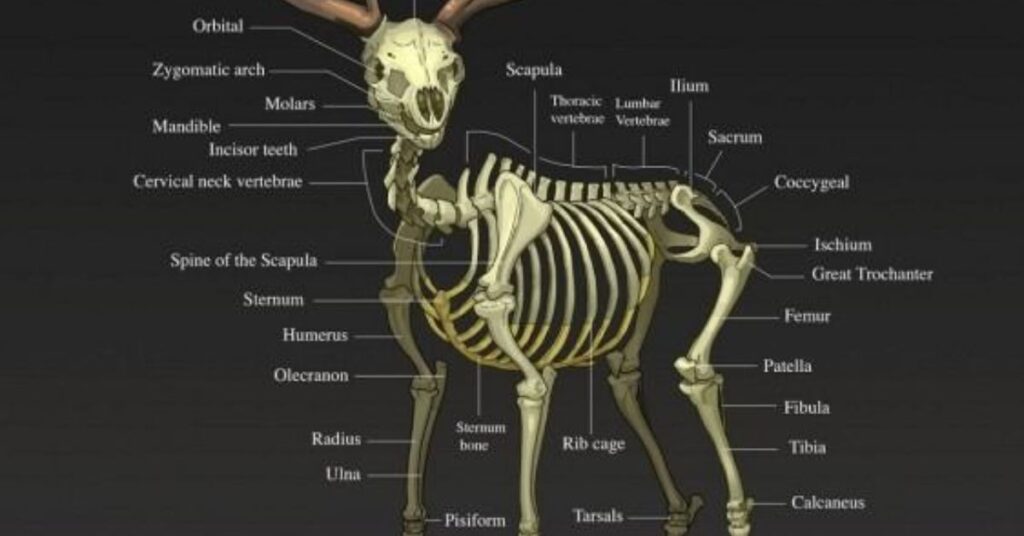Deer are fascinating creatures known for their agility, speed, and beauty. Whether you’re a wildlife enthusiast, hunter, or simply curious about these magnificent animals, understanding their anatomy is crucial to fully appreciate how they function in their natural environment. The deer anatomy, from their skeletal structure to their muscular and digestive systems, is uniquely adapted to help them thrive in the wild. In this article, we will explore the complex anatomy of deer and highlight key features that make them such extraordinary animals.
The Skeletal System: Strong and Adaptable
The deer’s skeleton is the foundation of its body, supporting its organs and allowing for swift movement. Deer have a lightweight yet strong skeletal structure, designed for speed and endurance. One of the most distinguishing features of their skeleton is the set of antlers, which are made of bone and shed annually. These antlers serve multiple purposes, including mate competition and establishing dominance within their social structure.
Deer have four legs, each ending in a cloven hoof, which provides them with excellent traction while running through various terrains. Their long legs and flexible joints enable them to cover large distances quickly, a trait that helps them escape predators. The pelvis of a deer is narrow, allowing for maximum speed and agility. The overall design of their skeleton allows them to remain light on their feet while maintaining a sturdy structure for survival.
The Muscular System: Built for Speed
Deer possess a muscular system designed for quick bursts of speed and efficient long-distance travel. Their muscles are built to provide both power and endurance, which is essential for evading predators. The muscle structure is especially strong in the hindquarters, giving the deer its incredible jumping ability and fast running speeds.
The muscles in the legs, particularly in the thighs, are responsible for driving the deer forward with powerful strides. Their muscular system is built for efficiency, allowing them to conserve energy over long distances while still being able to sprint at high speeds when necessary. This combination of strength and agility allows the deer to navigate difficult landscapes, such as forests, mountains, and meadows, with ease.
The Digestive System: A Specialized Process
Deer are herbivores, which means their digestive system is uniquely adapted to process plant material. They have a specialized stomach that is divided into four compartments, much like cows and other ruminants. This digestive system allows them to efficiently extract nutrients from tough plant matter, such as leaves, grass, and twigs.
The process begins when the deer ingests food, which is then fermented in the first compartment of their stomach. Here, microbes break down the food into digestible nutrients. The partially digested food is regurgitated, chewed again, and swallowed into the next compartments for further digestion. This multi-step process ensures that the deer can absorb the maximum amount of nutrients from its food, which is essential for maintaining energy and staying healthy.
The Respiratory System: Efficient Oxygen Intake
Deer rely on their respiratory system to maintain high energy levels, particularly during running or evading predators. Their lungs are large in proportion to their body size, enabling efficient oxygen intake. The respiratory system works in tandem with the cardiovascular system to ensure that oxygen is delivered to the muscles during periods of intense activity, such as running or leaping over obstacles.
When a deer is startled or needs to escape danger, its heart rate increases, and the body’s need for oxygen becomes even greater. This allows the deer to sustain high levels of exertion for short bursts, helping them outrun or outmaneuver potential threats. The efficient respiratory system is one of the reasons deer are so well-adapted for life in the wild.
The Circulatory System: Pumping Blood to Vital Organs
The circulatory system of a deer plays a critical role in ensuring that oxygen and nutrients reach all parts of the body. Deer have a four-chambered heart, which pumps blood efficiently to various organs. The heart rate of a deer can increase dramatically when it is under stress, helping it to meet the body’s increased demands for oxygen during physical exertion.
The circulatory system also plays a role in regulating body temperature, which is crucial for survival in a wide range of environments. In cold weather, blood vessels constrict to conserve heat, while in warmer climates, they dilate to release excess heat. This adaptability allows deer to thrive in a variety of climates, from snowy forests to warmer woodlands.
The Nervous System: Keen Senses and Quick Reflexes
Deer have a highly developed nervous system, which allows them to sense danger and react quickly. Their acute sense of smell, sight, and hearing are some of their most important survival tools. A deer’s sense of smell is particularly keen, allowing it to detect predators from a long distance. Their large, upright ears can swivel to pick up sounds from every direction, while their large eyes provide a wide field of vision, helping them spot potential threats in the environment.
The nervous system of a deer is wired for fast responses. When a deer detects danger, its body immediately reacts with heightened alertness, and it can flee in a matter of seconds. This quick response is essential for survival, as it allows the deer to evade predators before they can close the distance.
The Reproductive System: Ensuring Survival
The reproductive system of a deer plays a key role in the continuation of the species. Deer mating season, known as the rut, typically occurs during the fall. During this time, male deer, known as bucks, compete for the attention of females, called does. The rut is marked by intense behavior, including sparring with antlers, vocalizations, and scent marking.
Female deer typically give birth to a single fawn, although twins are not uncommon. The fawn is born in the spring, after a gestation period of around 230 days. Newborn fawns are often left hidden in dense foliage for the first few weeks of their lives, as they are vulnerable to predators. The mother returns periodically to nurse and care for her young.
The Sensory System: Superior Adaptations for Survival
Deer have evolved superior sensory capabilities to help them navigate the wild. Their eyes are adapted to detect motion, even in low-light conditions, which is essential for spotting predators in the twilight hours or during the night. Additionally, deer possess a remarkable ability to detect the faintest sounds, allowing them to be aware of their surroundings at all times.
Their sense of smell is perhaps their most vital sensory adaptation. Deer have an excellent sense of smell, capable of detecting pheromones, food, and even the scent of predators. This highly developed olfactory system is a key tool for identifying danger and making quick decisions about whether to flee or remain hidden.
The Immune System: Defending Against Threats
Deer have a robust immune system that helps protect them from diseases and infections in the wild. Their immune system is capable of responding to a wide variety of pathogens, from bacteria to viruses. Deer are also capable of producing antibodies to fight off infections and prevent illness. This helps them stay healthy, despite the numerous threats they face in their natural environments.
In addition to their immune system, deer also rely on their instincts to avoid contaminated food and water sources. This innate behavior helps protect them from disease and infection, further ensuring their survival.
Conclusion: The Marvel of Deer Anatomy
The complex anatomy of deer is a marvel of evolution, finely tuned to meet the demands of life in the wild. From their lightweight skeleton to their muscular system built for speed, each aspect of their body is designed to maximize survival. Their acute senses, efficient digestive system, and adaptable circulatory system all work together to help them evade predators, thrive in their habitats, and continue their species.
Deer are living examples of nature’s ingenuity, with each system working in harmony to ensure that they remain one of the most successful and widespread species in the animal kingdom. Understanding their anatomy gives us a greater appreciation for these remarkable creatures and the ways they have adapted to their environments.







